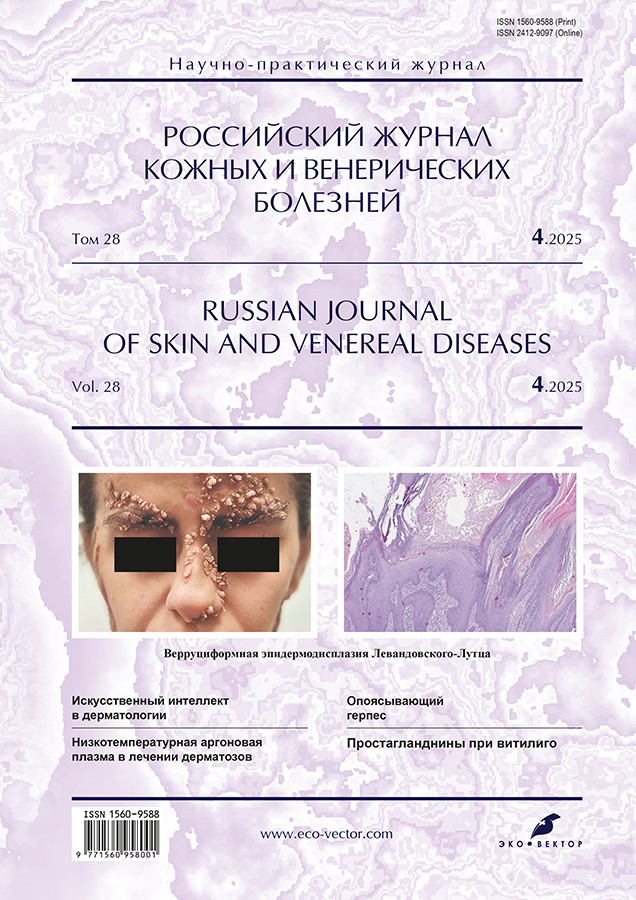Isotretinoin Lidose in clinical practice
- Authors: Pakhomova V.V.1, Krinitsyna Y.M.2, Senchukova S.R.2
-
Affiliations:
- Novosibirsk Regional Clinical Skin and Venereological Dispensary
- Federal Research Center of Fundamental and Translational Medicine
- Issue: Vol 28, No 4 (2025)
- Pages: 470-476
- Section: DERMATOLOGY
- URL: https://bakhtiniada.ru/1560-9588/article/view/350475
- DOI: https://doi.org/10.17816/dv681670
- EDN: https://elibrary.ru/UIKLCZ
- ID: 350475
Cite item
Abstract
Background: Systemic isotretinoin is recommended for the treatment of moderate to severe acne. The specialized Lidose modified-release technology has improved isotretinoin absorption in the gastrointestinal tract, increasing its bioavailability by 20%, thereby allowing a 20% dose reduction without compromising therapeutic efficacy.
Aim: The work aimed to estimate the clinical outcomes of isotretinoin Lidose in the treatment of moderate to severe acne.
Methods: A retrospective, uncontrolled, single-center study analyzed 2477 cases of systemic isotretinoin prescription in patients with moderate to severe acne, including 1912 women (77.2%) and 565 men (22.8%), with a mean age of 22.7 years; 290 patients (11.7%) had comorbidities. The daily therapeutic dose was calculated based on 0.4–0.8 mg/kg body weight, with a cumulative dose of 100–150 mg/kg. All patients underwent laboratory testing (complete blood count and biochemistry) before treatment, at 3 months, and at the end of therapy. For one month before systemic isotretinoin treatment, throughout the entire treatment course, and for one month after completion, female patients were advised to use at least one (preferably two) effective contraceptive method, including barrier contraception.
Results: After 6–12 months, all patients achieved complete clinical remission. By the end of therapy, skin oiliness and comedones disappeared, inflammatory lesions completely resolved, and skin texture became even. Among adverse events, cheilitis and xerosis were most frequently observed by weeks 2–3 and were successfully managed with moisturizers and lip balms. Transient elevations in transaminases and total cholesterol (within 10% of the normal range) were observed in 3.4% of cases, not requiring dose adjustment.
Conclusion: Systemic isotretinoin administration for moderate to severe acne allows achieving long-term clinical remission, which leads to a positive effect in preventing acne-related emotional distress. Retrospective analysis of isotretinoin Lidose use in clinical practice confirms not only its good tolerability but also its high efficacy in the treatment of moderate to severe acne.
Keywords
Full Text
##article.viewOnOriginalSite##About the authors
Vera V. Pakhomova
Novosibirsk Regional Clinical Skin and Venereological Dispensary
Email: nokvd@nso.ru
ORCID iD: 0009-0003-3197-334X
Russian Federation, Novosibirsk
Yulia M. Krinitsyna
Federal Research Center of Fundamental and Translational Medicine
Email: Juliya407@yandex.ru
ORCID iD: 0000-0002-9383-0745
SPIN-code: 5925-9031
MD, Dr. Sci. (Medicine), Professor
Russian Federation, 2 Timakova st, Novosibirsk, 630060Svetlana R. Senchukova
Federal Research Center of Fundamental and Translational Medicine
Author for correspondence.
Email: Senchukovas55@gmail.com
ORCID iD: 0000-0002-4637-1865
SPIN-code: 2191-8473
MD, Dr. Sci. (Medicine)
Russian Federation, 2 Timakova st, Novosibirsk, 630060References
- Dreno B, Poli F. Epidemiology of acne. Dermatology. 2003;206(1):7–10. doi: 10.1159/000067817
- Tan JK, Bhate K. A global perspective on the epidemiology of acne. Br J Dermatol. 2015;172(Suppl 1):3–12. doi: 10.1111/bjd.13462
- Vos T, Flaxman AD, Naghavi M, et al. Years lived with disability (YLDs) for 160 sequelae of 289 diseases and injuries 1990–2010: a systematic analysis for the Global Burden of Disease Study 2010. Lancet. 2012;380(9859):2163–2196. doi: 10.1016/S0140-6736(12)61729-2
- Samtsov AV. To the question of the effect of isotretinoin on the neuropsychic state of patients with acne. Vestnik dermatologii i venerologii. 2023;99(3):63–68. doi: 10.25208/vdv1414 EDN: QNQDES
- Andreeva EN, Sheremet’eva EV, Grigorian OR, Absatarova YuS. Acne is a disease of civilization. Russian journal of human reproduction. 2020;26(1):6-12. doi: 10.17116/repro2020260116 EDN: SSYABA
- Khunger N, Mehrotra K. Menopausal acne: challenges and solutions. Int J Womens Health. 2019;11:555–567. doi: 10.2147/IJWH.S174292
- Stamu-O’Brien C, Jafferany M, Carniciu S, Abdelmaksoud A. Psychodermatology of acne: psychological aspects and effects of acne vulgaris. J Cosmet Dermatol. 2021;20(4):1080–1083. doi: 10.1111/jocd.13765
- Bassi R. Is acne a psychosomatic disease? In: 9th Congress EADV, 2000 Oct 11-15. Geneva, Switzerland; 2000. Р. 17.
- Beisert M, Pilarczyk K, Zakrzewska M, Pawlaczyk M. Sexual satisfaction and self-esteem in women with acne. J Cosmet Dermatol. 2019;19(7):1768–1773. doi: 10.1111/jocd.13207
- Afsar FS, Seremet S, Duran HD, et al. Sexual quality of life in female patients with acne. Psychol Health Med. 2020;25(2):171–178. doi: 10.1080/13548506.2019.1679845
- Huang CY, Chang IJ, Bolick N, et al. Comparative efficacy of pharmacological treatments for acne vulgaris: a network meta-analysis of 221 randomized controlled trials. Ann Fam Med. 2023;21(4):358–369. doi: 10.1370/afm.2995
- Nast A, Dreno B, Bettoli V, et al. European evidence-based (S3) guideline for the treatment of acne-update 2016, short version. J Eur Acad Dermatol Venereol. 2016;30(8):1261–1268. doi: 10.1111/jdv.13776
- Reed ML, Stanley J, Stengel F, et al. Mal de Meleda treated with 13-cisretinoic acid. Arch Dermatol. 1979;115(5):605–608.
- Norris DA, Osborn R, Robinson W, Tonnesen MG. Isotretinoin produces significant inhibition of monocyte and neutrophil chemotaxis in vivo in patients with cystic acne. J Invest Dermatol. 1987;89(1):38–43. doi: 10.1111/1523-1747.ep12580370
- Sakania LR, Plieva KT, Korsunskaya IM. Algorithm of descending doses of retinoids in the treatment of acne resistant to standard treatment methods. Russian journal of Clinical dermatology and venereology. 2016;15(2):72–76. doi: 10.17116/klinderma201615272-76 EDN: VZLKED
- Dispenza M, Wolpert EB, Gilliland KL, et al. Systemic isotretinoin therapy normalizes exaggerated TLR-2-mediated innate immune responses in acne patients. J Invest Dermatol. 2012;132(9):2198–2205. doi: 10.1038/jid.2012.111
- Araviyskaya ER. Severe acne: analysis of some modern methods of treatment. Pharmateca. 2017;(S1):38–43. EDN: YIATLR
- Costa CS, Bagatin E, Martimbianco AL, et al. Oral isotretinoin for acne. Cochr Database Syst Rev. 2018;11(11):CD009435. doi: 10.1002/14651858.CD009435.pub2
- Loh ZH, Samanta AK, Wan Sia Heng P. Overview of milling techniques for improving the solubility of poorly water-soluble drugs. Asian J Pharmaceutical Sci. 2015;10(4):255–274. doi: 10.1016/j.ajps.2014.12.006
- Olisova O. Yu, Ma Ts. Efficacy vs ineffectiveness of systemic retinoids in acne. Effective pharmacotherapy. 2020;16(9):18–24. doi: 10.33978/2307-3586-2020-16-9-18-22 EDN: BIUECI
- Olisova OY, Kukes IV. On the issue of the effectiveness and bioequivalence of isotretinoin Lidose. Russian journal of skin and venereal diseases. 2024;27(2):179–187. doi: 10.17816/dv629705 EDN: HYEYRB
Supplementary files








